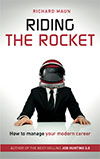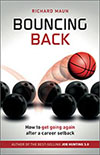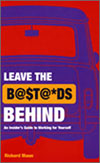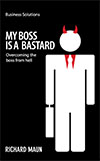better business blog
Tips and stories to add value to you and your organisation

How Not To Coach People
I was told this story the other day by a colleague and just had to treat you to it, if only because it is true and, from my perspective as a coach who likes to build a safe environment; appalling. My colleague dubs this work ‘fairy coaching’ and I tend to agree with him, on the basis that it falls into the happy-clappy-hessian-knitted-teepee brand of coaching which can give life/business coaching a bad name. See what you think, here’s the story:
At his place of work my colleague has an MD who likes to hire the services of a particular ‘coach’ to help team development and promote harmony. The ‘coach’ likes to get people down and dirty on bean bags, which is not always the best way to make people feel comfortable (the client should choose, not the coach). Last month the team were treated to a new way to confront their fears. They all caught the train into London and when they disembarked at Paddington a soap-box was produced and one by one the team had to stand on it and shout out their fears to bemused commuters.
Yes really!
I had thought this kind of misguided exercise had been binned at the end of the 90’s, along with suspect outward-bound style management ‘bonding’ weekends, which only served to create ill-feeling amongst staff and in no way replicated the working life of the business. (I’ve been on three of these and having learned to abseil, found that this wasn’t a great deal of help when trying to plan a complex factory).
No New Learning
Having finished on the soap-box what did my colleague learn? Only to avoid the police, who asked the group to “Move along please” as a shop owner complained they were blocking her flower stall. The experience also confirmed my colleague’s suspicions about ‘fairy coaching’ and as for team harmony, well you can guess the general reaction to the stunt.
Safety Counts
Coaching starts with clear contracting to build a safe environment. If there isn’t a contract then in the words of an experienced Supervisor: “You don’t do no coaching.” If only more people understood this and realised that coaching is client-centred, not ego-centred, then the world and my colleague would both be a bit happier.
Tags: coaching, contracting, How To
How To Get More From Meetings
Meetings are a short cut to a full diary and it’s curious that we need to have them at work, in order to canvass opinion and make decisions, yet we rarely feel the need to have them at home. Pause for a moment and consider all the hours we are going to spend in meetings over the next 12 months… More than you might think perhaps?
However, I attended a business meeting recently which was more useful than some others I’ve been to and for two specific reasons:
- We started off by talking about our frustrations.
- We then stopped talking and did some work.
Naming Frustrations
Everybody has feelings and when people work together for any length of time they are bound to accumulate niggles, gripes, concerns, irritations or grazes to their ego. Perhaps a deadline was missed, a promise only half made good on, or an email sent that was misinterpreted. Whatever the cause of these things, we tend to carry them around with us and they can affect how well we perform at meetings, because they can get in the way of our rational Adult Ego State thinking.
Adult and Ego State are terms from Transactional Analysis and when we’re said to be “in our Adult” we are being rational and objective and using facts. Often people think they are being objective, when in fact their feelings are making them sulk, or withdraw from the discussion, or they make commitments without thinking through the implications. Therefore, at the start of a meeting it can help to invite people to name their frustrations. We did this in our meeting by asking each other:
- Where are you?
- What’s annoying you?
- You look thoughtful…what’s on your mind?
- What is getting in the way?
- What has to change for you to feel comfortable?
By asking these questions and giving us all a chance to be heard (see Active Listening post) we had a frank and honest discussion and took note of people’s concerns. This meant that we unpacked our issues and ‘put them on the table’ where we could see them. As the old adage runs: If you can see it, you can sort it. This is the same for our frustrations; if we can see them then we can sort them out and that clears the way for a more productive meeting, as we are now more likely to feel included and engaged.
Encouraging people to speak up is a cornerstone of good team dynamics and successful meetings. The way to voice your feelings without offending people is to focus on your feelings and connect to an issue, rather than the person, and to use a sentence construction such as:
“When you do this / say this….I feel that…..and I would like us to consider these options…”
When people are given options it encourages them to think…which can move them out of a sulky place and into their Adult Ego State. Questions for people to consider here include:
- What would you like to happen?
- How many options can we explore?
Active Meetings
The trap that we had fallen into in the past was to use all of our meeting time to collect actions, which we would then go away and work on. I’m coming to the conclusion that busy people do better when they block their time into useful chunks, rather than having tiny bits of work all overlapping and competing for attention. Given that we can block out time for a meeting, but then have to reschedule our diary to find time to do the actions arising, it makes sense to treat a meeting as a block of productive time, rather than just a conversation. My thinking is to allow enough space in a meeting to do some or all of the actions there and then, so that we make better use of our time together. Our meetings stop being passive and become active.
As a case in point; during our recent meeting we stopped writing actions about administrative items and simply reached for invoices, diaries, cheque books and spreadsheets and made payments, updated information and organised appointments. This felt good, because we were being more productive with our time. I noticed that at one point I didn’t have anything particular to do, so I checked emails; which was still a good use of my time. Meetings are a collective activity, so the focus is on collective progress rather than maximising individual progress. From a business perspective if two actions are completed that’s two steps forwards for the business and that’s what really counts, not individual progress.
When you are looking at your diary and wondering how you will fit all your meetings in perhaps reflect on these questions:
- What can you do differently?
- When you are planning a meeting think about what items can be actioned during the meeting itself to make better use of the time, so the whole group/business makes progress?
- How does the agenda need to change to reflect a more purposeful approach?
Meetings can easily slip and slide into ‘talking shops’ so it was good to be reminded that they can be sharpened up. I hope your meetings go well and do let me know if you have any tips you would like to share.
More Time Management Tips
There are more tips and practical suggestions in the Time Management Pack in the shop, including the Drivers model, which is one of the most useful bits of thinking I have come across and which has helped me to really improve the way I work. Do you know your Driver preferences? They’re worth finding out.
Tags: Adult Ego State, coaching, feelings, How To, meetings, time management, Transactional Analysis
e-publishing
Click icon for details


recent posts
browse archive
books
Click cover to view details on Amazon
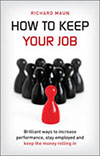
How to Keep Your Job
Brilliant ways to increase performance, stay employed and keep the money rolling in
Published 2011 Marshall Cavendish
208pp
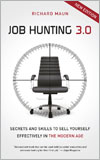
Job Hunting 3.0
Secrets and skills to sell yourself effectively in the Modern Age
Published 2010 Marshall Cavendish
260pp

 RSS
RSS

